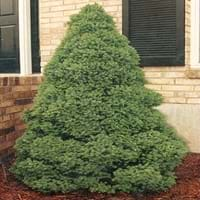Life Span
Annual or Biennial
Perennial
Type
Vegetable
Needled or Scaled Evergreen
Origin
Europe, Northern Africa, Asia
Canada
Types
Not Available
Not available
Habitat
Coastal Regions, Marshy ground, Wet ground
Mountains, subtropical regions
USDA Hardiness Zone
Not Available
2-7
Sunset Zone
Not Available
A1, A2, A3, 1a, 1b, 2a, 2b, 3a, 3b, 4, 5, 6, 7, 14, 15, 16, 17
Habit
Upright/Erect
Pyramidal
Flower Color
White
Not Available
Flower Color Modifier
Bicolor
Bicolor
Fruit Color
Tan, Brown
Not Available
Leaf Color in Spring
Light Green
Light Green, Gray Green
Leaf Color in Summer
Green, Light Green
Green, Gray Green
Leaf Color in Fall
Green, Light Green
Green, Gray Green
Leaf Color in Winter
Not Available
Green, Gray Green
Leaf Shape
Irregular
Needle like
Plant Season
Spring, Summer
Spring, Summer, Fall, Winter
Sunlight
Full Sun
Full Sun, Partial Sun
Type of Soil
Loam
Loam, Sand
The pH of Soil
Neutral, Alkaline
Acidic, Neutral
Soil Drainage
Well drained
Average
Bloom Time
Late Spring
Not Available
Tolerances
Drought
Drought
Where to Plant?
Container, Ground
Container, Ground, Pot
How to Plant?
Seedlings, Transplanting
Cuttings, Grafting
Plant Maintenance
Low
Medium
Watering Requirements
Keep ground moist, Requires regular watering
Average Water Needs, Do Not over Water, Requires regular watering
In Summer
Lots of watering
Lots of watering
In Spring
Moderate
Moderate
In Winter
Average Water
Average Water
Soil pH
Neutral, Alkaline
Acidic, Neutral
Soil Type
Loam
Loam, Sand
Soil Drainage Capacity
Well drained
Average
Sun Exposure
Full Sun
Full Sun, Partial Sun
Pruning
Remove damaged leaves, Remove shoots
Remove damaged leaves, Remove dead branches, Remove dead leaves
Fertilizers
Less fertilizing
All-Purpose Liquid Fertilizer
Pests and Diseases
Bacteria, Downy mildew, Fungal Diseases, fungus, Mosaic viruses, Pink Root, Red blotch
Aphids, Canker, Free of serious pests and diseases, Needle rust, Scale
Plant Tolerance
Frost
Drought
Flowers
Showy
Insignificant
Flower Petal Number
Single
Single
Fragrant Bark/Stem
Yes
No
Foliage Texture
Coarse
Fine
Foliage Sheen
Glossy
Matte
Attracts
Insects, Mice, Rodents, Spider Mites
Butterflies, Flying insects, Hummingbirds
Allergy
Irritation to stomach
Not Available
Aesthetic Uses
Not Used For Aesthetic Purpose
Showy Purposes, Used as Christmas tree
Beauty Benefits
Good for skin, Improve skin condition, Moisturizing, Skin Problems
Not Available
Edible Uses
Yes
Not Available
Environmental Uses
Air purification, Food for animals, Food for birds, Food for insects
Air purification, Windbreak
Medicinal Uses
Cancer, Combats Stress, Eye Problems, High blood pressure, High cholestrol, Indigestion, Inflammation, Weight loss
Not Available
Part of Plant Used
Leaves, Seeds
Flowers, Inner Bark, Seeds
Other Uses
Employed in herbal medicine, Oil is used in perfume, soaps, creams, etc., Used As Food, Used for its medicinal properties, Used as a spice
Paper pulp, Wood is used in construction
Used As Indoor Plant
Yes
No
Used As Outdoor Plant
Yes
Yes
Garden Design
Container, Edible, Herb / Vegetable
Container, Feature Plant, Foundation, Mixed Border, Rock Garden, Wall, Screening, Wind Break
Botanical Name
APIUM graveolens
PICEA glauca var. albertiana 'Conica'
Common Name
Celery
Dwarf Alberta Spruce
In Hindi
अजवायन
Dwarf Alberta Spruce
In German
Sellerie
Dwarf Alberta Fichte
In French
Céleri
Dwarf Alberta Spruce
In Spanish
Apio
Enano Alberta Spruce
In Greek
Σέλινο
Νάνος Αλμπέρτα Spruce
In Portuguese
Aipo
Anão Alberta Spruce
In Polish
Seler
Dwarf Alberta Spruce
In Latin
apium
Spruce Alberta Nane
Phylum
Tracheophyta
Coniferophyta
Class
Magnoliopsida
Pinopsida
Clade
Angiosperms, Asterids, Eudicots
Not Available
Tribe
Apieae
Not Available
Subfamily
Apioideae
Piceoideae
Number of Species
Not Available
Season and Care of Celery and Dwarf Alberta Spruce
Season and care of Celery and Dwarf Alberta Spruce is important to know. While considering everything about Celery and Dwarf Alberta Spruce Care, growing season is an essential factor. Celery season is Spring and Summer and Dwarf Alberta Spruce season is Spring and Summer. The type of soil for Celery is Loam and for Dwarf Alberta Spruce is Loam, Sand while the PH of soil for Celery is Neutral, Alkaline and for Dwarf Alberta Spruce is Acidic, Neutral.
Celery and Dwarf Alberta Spruce Physical Information
Celery and Dwarf Alberta Spruce physical information is very important for comparison. Celery height is 45.70 cm and width 30.50 cm whereas Dwarf Alberta Spruce height is 180.00 cm and width 120.00 cm. The color specification of Celery and Dwarf Alberta Spruce are as follows:
Celery flower color: White
Celery leaf color: Light Green
Dwarf Alberta Spruce flower color: Not Available
- Dwarf Alberta Spruce leaf color: Light Green and Gray Green
Care of Celery and Dwarf Alberta Spruce
Care of Celery and Dwarf Alberta Spruce include pruning, fertilizers, watering etc. Celery pruning is done Remove damaged leaves and Remove shoots and Dwarf Alberta Spruce pruning is done Remove damaged leaves, Remove dead branches and Remove dead leaves. In summer Celery needs Lots of watering and in winter, it needs Average Water. Whereas, in summer Dwarf Alberta Spruce needs Lots of watering and in winter, it needs Average Water.





